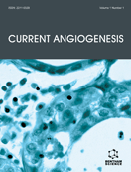Abstract
Osteoarthritis (OA), one of the commonest joint diseases of unknown aetiology is a major source of pain and disability in the ageing population. OA is associated with chondropathy, synovitis, subchondral bone remodelling and osteophyte formation. Angiogenesis, the growth of new blood vessels from preexisting ones may contribute to each of these features. Synovitis is increasingly recognised as an important feature of OA and drives synovial angiogenesis through macrophage activation. Pain is the predominant symptom of OA, but little is known about the mechanism by which this pain arises. Angiogenic modulators link vessel and nerve growth in OA. Calcium/calmodulin-dependent protein kinase II (CaMKII); a complex serine/threonine kinase may be involved in modulating angiogenesis-mediated pathologies seen in OA. This review focuses on the role of angiogenesis in inflammation, joint damage and pain in OA, the potential contributions of CaMKII to each of these features and whether CaMKII is a good molecular therapeutic target to inhibit angiogenesis and control synovitis, joint damage and pain in OA.
Keywords: Angiogenesis, bone, calcium/calmodulin-dependent protein kinase II, inflammation, nerves, osteoarthritis, pain, synovium.
Graphical Abstract
 20
20

